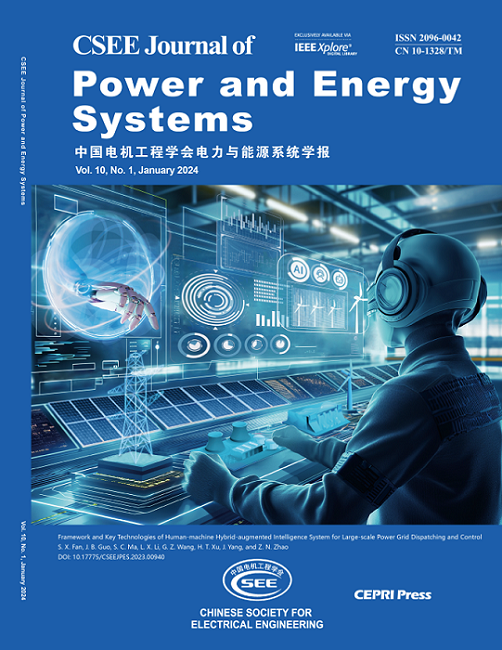考虑风电机组运行区域扩大的风电场临时频率支持优化
IF 5.9
2区 工程技术
Q2 ENERGY & FUELS
引用次数: 0
摘要
风力发电厂(WPPs)越来越多地被授权在涉及重大电力短缺的突发事件期间为电力系统提供临时频率支持。然而,水电厂在降额作业下的频率支持能力仍然没有得到充分的调查,这突出了进一步改善频率最低点的潜力。提出了一种WPP双级优化临时频率支持(OTFS)策略。OTFS策略的实现由单个风力机控制器和中央WPP控制器协同完成。首先,利用小波变换的频率支持能力,在小波变换控制器中开发了一种新的动态功率控制方法,扩大了小波变换的稳定工作区域。这种方法将wt的临时频率支持与同步发电机的二次频率控制协同起来,使wt能够释放更多的动能,而不会导致二次频率下降。其次,提出了WPP控制器的模型预测控制策略。该策略确保了在扩展稳定区域内运行的多个WTs协调一致,通过有效的动能利用来最小化频率下降的幅度。最后,在实时仿真平台上进行了全面的案例研究,验证了所提策略的有效性。本文章由计算机程序翻译,如有差异,请以英文原文为准。
Optimized Temporary Frequency Support for Wind Power Plants Considering Expanded Operational Region of Wind Turbines
Wind power plants (WPPs) are increasingly mandated to provide temporary frequency support to power systems during contingencies involving significant power shortages. However, the frequency support capabilities of WPPs under derated operations remain insufficiently investigated, highlighting the potential for further improvement of the frequency nadir. This paper proposes a bi-level optimized temporary frequency support (OTFS) strategy for a WPP. The implementation of the OTFS strategy is collaboratively accomplished by individual wind turbine (WT) controllers and the central WPP controller. First, to exploit the frequency support capability of WTs, the stable operational region of WTs is expanded by developing a novel dynamic power control approach in WT controllers. This approach synergizes the WTs' temporary frequency support with the secondary frequency control of synchronous generators, enabling WTs to release more kinetic energy without causing a secondary frequency drop. Second, a model predictive control strategy is developed for the WPP controller. This strategy ensures that multiple WTs operating within the expanded stable region are coordinated to minimize the magnitude of the frequency drop through efficient kinetic energy utilization. Finally, comprehensive case studies are conducted on a real-time simulation platform to validate the effectiveness of the proposed strategy.
求助全文
通过发布文献求助,成功后即可免费获取论文全文。
去求助
来源期刊

CSEE Journal of Power and Energy Systems
Energy-Energy (all)
CiteScore
11.80
自引率
12.70%
发文量
389
审稿时长
26 weeks
期刊介绍:
The CSEE Journal of Power and Energy Systems (JPES) is an international bimonthly journal published by the Chinese Society for Electrical Engineering (CSEE) in collaboration with CEPRI (China Electric Power Research Institute) and IEEE (The Institute of Electrical and Electronics Engineers) Inc. Indexed by SCI, Scopus, INSPEC, CSAD (Chinese Science Abstracts Database), DOAJ, and ProQuest, it serves as a platform for reporting cutting-edge theories, methods, technologies, and applications shaping the development of power systems in energy transition. The journal offers authors an international platform to enhance the reach and impact of their contributions.
 求助内容:
求助内容: 应助结果提醒方式:
应助结果提醒方式:


